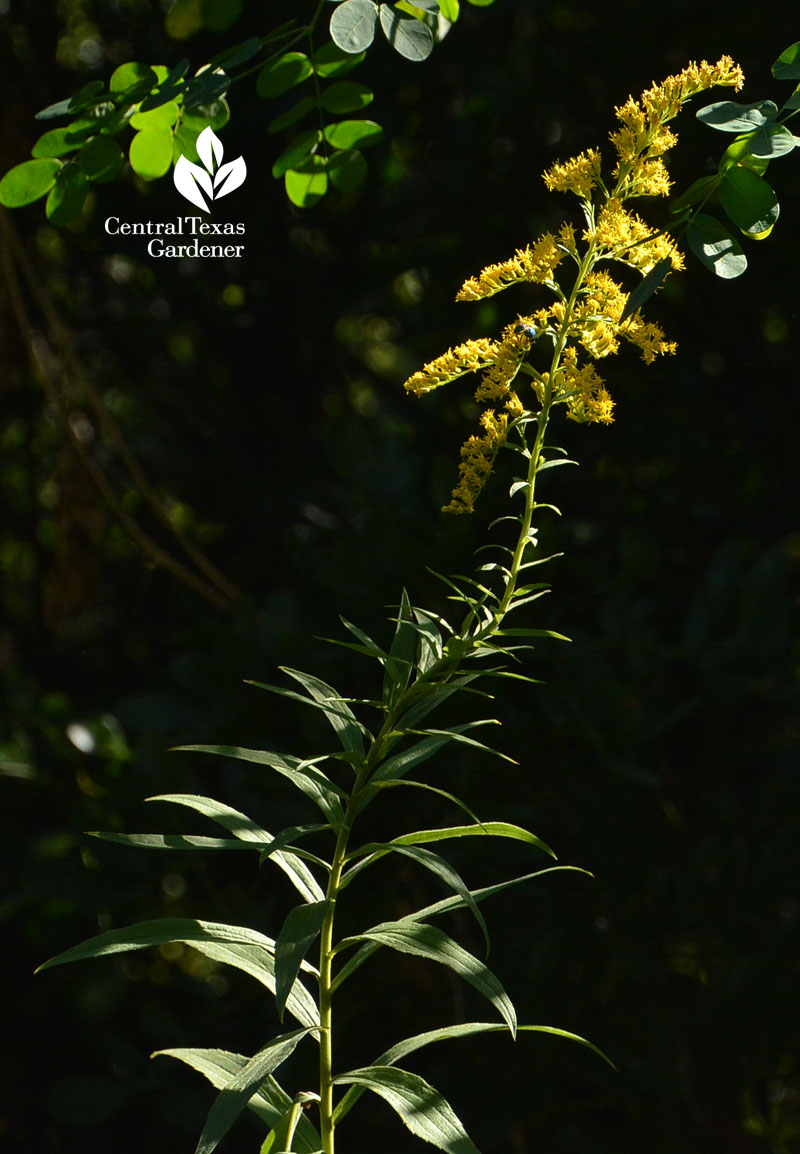October 6, 2016
Native Trees for Wildlife & No Lawn Habitat Makeover
In my garden, goldenrods plopped themselves down in back long ago.

They’re a bit thuggish, but Texas weird weather never deters them from feeding pollinators come fall.

Some of my Turk’s caps are a tad spindly and disgraceful thanks to zany weather. Still, they keep serving up meals for bees and Gulf Fritillary butterflies.

White mistflower (Ageratina havanensis), also called shrubby boneset, is about to hit high gear for pollinators waiting in the wings.

Early last week, bees and others were all over native Barbados cherry (Malpighia glabra) flowers.

Already, they’re pushing out “cherries” that are edible for us, but I leave them for the birds.

Texas Native Plant Week is coming up October 16- 22, though Eva Van Dyke celebrates native plants all year long in her home garden and at Barton Springs Nursery. She joins Tom this week to pick some native trees, large and small, that provide habitat and food for beneficial wildlife all year.

Get her list for native trees, like Texas or Blanco crabapple, shrubs, perennials, grasses, and groundcovers.

So, under all those shade trees, you’ve got—shade. Daphne explains how to cover the ground with low-care sedges.

Every year, viewers ask: “Is it okay to rake leaves directly onto beds?” YES, Daphne says. Find out why.
All plants need water. But I admit that I never thought about watering can ergonomics to make it easier. John analyzes balance and durability to pick the right one for the job.

There are darling, long-lasting ones for patio plants and indoor plants. The narrow spout keeps down the “Oops, furniture spill” mess inside.

If you’d rather recycle your plastic bottles for small jobs, an inexpensive option is to top them off with a screw on bottle top waterer.

On tour, Anne Bellomy took out lawn and soldierly shrubs for drought-tough layers that support wildlife from treetops to ground level. When she started, it looked like this. Photo by Anne Bellomy.

Here’s her in-progress shot.

Within a few years, she’d achieved her goal to create a wildlife oasis for resident and migratory creatures.

Anne chose native perennials like Engelmann daisy to power flower pollinators and to feed small birds, like goldfinches, on later seeds.


Silvery Yucca pallida structures up against bee-loved Salvia greggi and blackfoot daisy.

In back, built-up berms on her heavy soil support frothy-flowered Lindheimer muhly and deer muhly.

Autumn bloomers Mexican mint marigold and native Salvia leucantha team up for a classic color combo that’s edible, too. Pollinators chow down on both plants; we flavor recipes with Mexican mint marigold’s tarragon taste.

And since we all face this “household” situation, here’s how Anne disguised the trash bin that matches her open weave fence.

Watch her whole story now!
Finally, CTG is so very honored to be awarded the Gold for Best Overall Broadcast Media by the Garden Writers Association!

Thanks for stopping by! See you next week, Linda

